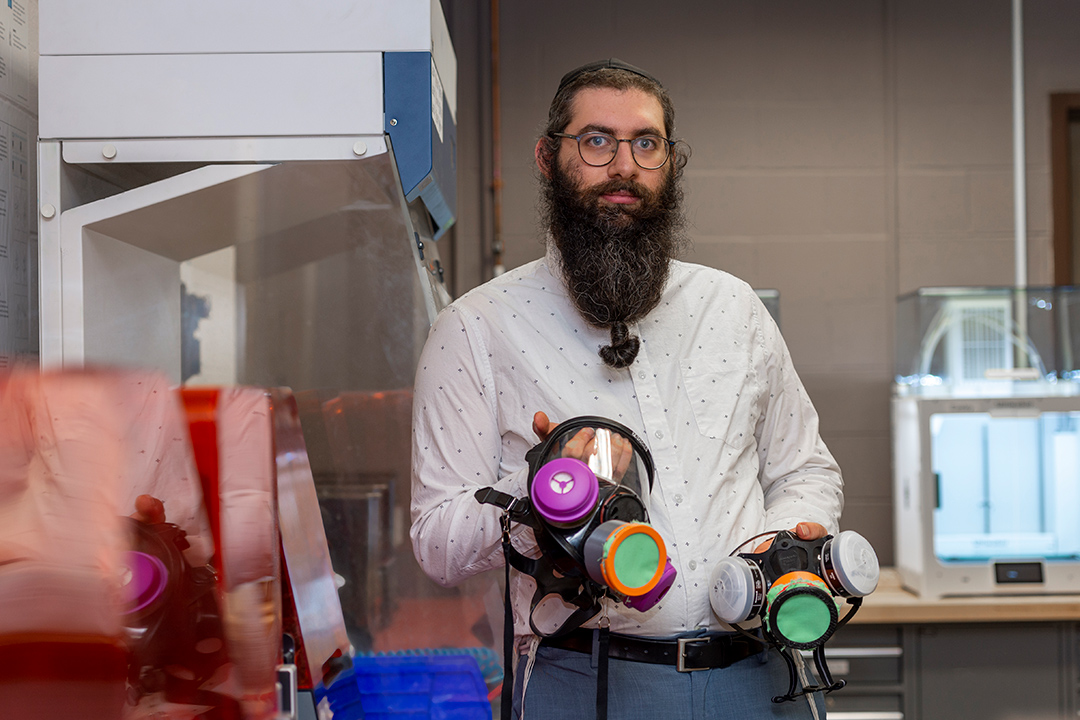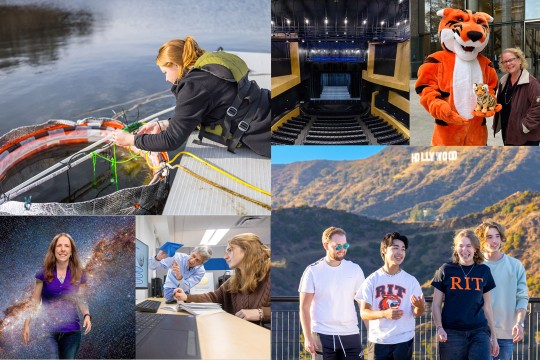RIT designer creates solution to protect chemical respirator users during the pandemic
Elizabeth Lamark
Dan Gabber, the digital fabrication specialist in RIT’s College of Art and Design, has designed and 3D printed brightly colored exhalation valve covers to protect wearers of chemical respirators working in collaborative environments during the global pandemic.
The digital fabrication specialist in RIT’s College of Art and Design has developed a creative solution that has universally stymied users of chemical respirators working in collaborative environments during the global pandemic.
The problem? Researchers, staff, and students using an air-purifying respirator (or APR), which has exhalation valves, are now required to also use masks for protection against the spread of COVID-19. Yet while it’s possible to wear masks in combination with some respirator types, it’s problematic—or virtually impossible—with most.
Enter Dan Gabber ’17 (industrial design), ’19 MFA (ceramics), the digital fabrication specialist in the College of Art and Design’s Fabrication Lab, who has designed and 3D printed brightly colored exhalation valve covers to solve the problem.
Elizabeth Lamark
Dan Gabber’s innovative design has been met with unanimous praise and appreciation across the RIT campus, including from the university’s top health officials.
“What he’s done is design a simple-yet-elegant cover that effectively combines the requirements of the APR and the mask into one,” said Jennifer Schneider, the Eugene H. Fram Chair of Applied Critical Thinking and a professor in the Department of Civil Engineering Technology, Environmental Management and Safety.
“Dan’s solution will provide the necessary protections required by the CDC (Centers for Disease Control and Protection) and the RIT Ready Safety Plan for researchers and staff, faculty, and students in several colleges across campus that require respiratory protection,” added Judy Foster, assistant director of Environmental Health and Safety, Global Risk Management Services in Finance and Administration at RIT.
As if solving such an issue wasn’t challenging enough, RIT encountered significant roadblocks procuring a sufficient supply of respirators for required annual fit testings due to the pandemic and raging wildfires out west.
“Respirators were really in short supply this year,” said Will Tracey, operations manager for the School of Art and the School of Design in the College of Art and Design. “We placed orders over the summer that weren’t fulfilled until late September, so we didn’t have respirators in hand to know where we were going with this until early October.”
After some initial brainstorming and prototyping, Gabber began creating multiple iterations of the valve covers that needed to account for a wide range of meticulous variables.
“We needed to create a cap for the valve that would allow us to layer two pieces of breathable fabric and wouldn’t break the seal around the face when exhaling due to backpressure, requiring me to iterate with each 3D print,” Gabber said. “There are a number of material properties that are unique to this process, which made working out the tolerances and the clipping mechanism an interesting challenge.”
“Dan was the mastermind behind all of the production,” Tracey said. “We had some working prototypes in only a few days.”
Gabber’s innovative design has been met with unanimous praise and appreciation across the RIT campus, including from the university’s top health officials.
“RIT innovation and ingenuity at its best,” said Dr. Wendy Gelbard, RIT associate vice president for Wellness.
“This is really exciting,” said Dr. Lindsay Phillips, RIT Student Health Center medical director. “I think it’s an ingenious solution.”
According to Schneider, Gabber’s design solution builds on RIT’s long legacy for supporting, evaluating, and implementing safety for individuals using personal protective equipment (PPE) across campus and the region, and as the OSHA Region II Training Institute Education Center.
“This has not only solved a huge challenge for RIT but wrestled an issue that’s a much bigger problem,” Schneider said.
Editor’s note: Schneider is a Doctor of Science (Sc.D.) and a Certified Industrial Hygienist (CIH). Foster also is a CIH and a Certified Safety Professional (CSP).







